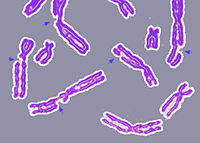
Photo from wikipedia
PurposeWe aimed to explore the expression of DNA damage response machinery proteins and their integrated prognostic value in different subgroups of breast cancer.MethodsExpression of NBS1, BRCA1, BRCA2, ATM, and p53… Click to show full abstract
PurposeWe aimed to explore the expression of DNA damage response machinery proteins and their integrated prognostic value in different subgroups of breast cancer.MethodsExpression of NBS1, BRCA1, BRCA2, ATM, and p53 was determined by immunohistochemistry in 419 surgically resected breast tumors.ResultsLoss of NBS1, BRCA1, ATM, and abnormal p53 expression was significantly associated with lower disease-free survival rates. Abnormal DNA damage response protein expression, defined as loss of any one of NBS1, BRCA1, ATM, and/or abnormal p53 expression, was observed in 258 of 399 evaluable cases (64.7%) and was significantly associated with higher tumor grade, larger tumor size, and ER-negative, and/or PR-negative status. Most patients with luminal B (86.1%), HER2-enriched (94.4%), and triple-negative (86.8%) breast cancers had abnormal DNA damage response protein expression. In contrast, abnormal DNA damage response protein expression was found in only 53.8% of luminal A tumors. Abnormal DNA damage response protein expression was associated with significantly lower 5-year disease-free survival rates in all patients (95.6% vs. 84.8%, p = 0.001), as well as in the luminal A subgroup (97.4% vs. 89.0%, p = 0.011). In multivariate analysis, abnormal DNA damage response protein expression remained an independent predictor of shorter disease-free survival for luminal A subtype (hazard ratio 3.14, 95% confidence interval 1.16–8.47; p = 0.024).ConclusionAbnormal DNA damage response protein expression is found in most luminal B and HER2-enriched breast cancers as frequently as in triple-negative breast cancer. In the luminal A subtype, abnormal DNA damage response protein expression is an independent prognostic marker.
Journal Title: Breast Cancer Research and Treatment
Year Published: 2019
Link to full text (if available)
Share on Social Media: Sign Up to like & get
recommendations!